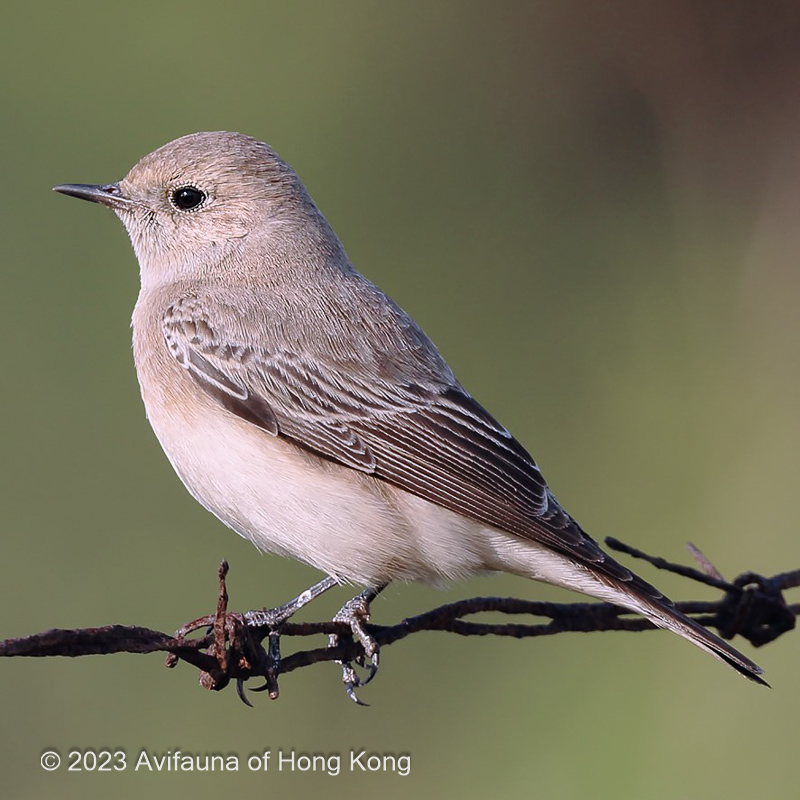Pied Wheatear Oenanthe pleschanka 白頂䳭
Category I. Accidental.
IDENTIFICATION

Nov. 2013, Michelle and Peter Wong. First-winter.
15-16 cm. The white rump and white base to the outer tail feathers contrasting with a black inverted T over the rest of the tail are characteristic of wheatears. The tail of Pied Wheatear is distinctive in having a relatively thin black terminal band with a black extension running a little way up the sides.
First-winter Pied Wheatears show cold brown upperparts that have pale fringes in fresh plumage. They have a faint supercilium and darker lores. The underparts are white and there is a brown wash across the breast.

Jun. 2010, Xinjiang, China, Koel Ko. Adult male.
The breeding adult male (not recorded in HK) has a whitish crown and nape, with blackish face, throat and upperparts. The underparts are white. The non-breeding male is duller with browner upperparts and feathers and orange-buff underparts. The adult female (not recorded in HK) has dull brown head and upperparts, a greyish-brown throat and upper breast and off-white lower breast, belly and vent.
VOCALISATIONS
A short, buzzing ‘tzzek’.
DISTRIBUTION & HABITAT PREFERENCE
Both records have occurred in coastal locations. The first was ‘exposed rock and open earth with very little grass or other cover’ (Smith 1990), while the second occurred in a grassy area.
OCCURRENCE
1989: a first-winter at Wah Fu during 24-25 September (Smith 1990).
2013: a first-winter at West Kowloon on 30 November.
RANGE & SYSTEMATICS
Monotypic. Pied Wheatear is a long-distance migrant from its wintering grounds in northeast Africa and Arabia to southeast Europe east to the southern Urals, Mongolia, Transbaikalia, Afghanistan, north Pakistan, the northwest Himalayas and northeast China (Collar 2020). In China it breeds from Xinjiang east to Liaoning and south to north Henan (Liu and Chen 2020). It has been recorded as a vagrant in Korea, Japan and Taiwan (Clement and Rose 2015).
BEHAVIOUR, FORAGING & DIET
Hops and runs on the ground. Readily perches on exposed rocks, bushes and man-made structures such as wire fences.
The bird at Wah Fu fed by “both catching insects (presumably) on the ground, descending from vantage points up to 10 metres high to do so, and also by flycatching upwards from a perch to a height of about 20 metres” (Smith 1990)
CONSERVATION STATUS
IUCN: Least Concern. Population trend stable.
Clement, P. and C. Rose (2015). Robins and Chats. Christopher Helm, London.
Collar, N. (2020). Pied Wheatear (Oenanthe pleschanka), version 1.0. In Birds of the World (J. del Hoyo, A. Elliott, J. Sargatal, D. A. Christie, and E. de Juana, Editors). Cornell Lab of Ornithology, Ithaca, NY, USA. https://doi.org/10.2173/bow.piewhe1.01
Liu, Y. and Y. H. Chen (eds) (2020). The CNG Field Guide to the Birds of China (in Chinese). Hunan Science and Technology Publication House, Changsha.
Smith, S. (1990). Pied Wheatear at Wah Fu. The First Record for Hong Kong. Hong Kong Bird Report 1989: 92 – 95.

